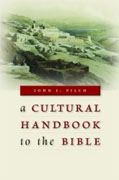A Cultural Handbook to the Bible
John J. Pilch
book reviews:
· general fiction
· chick lit/romance
· sci-fi/fantasy
· graphic novels
· nonfiction
· audio books
· author interviews
· children's books @
curledupkids.com
· DVD reviews @
curledupdvd.com
newsletter
win books
buy online
links
home
for authors
& publishers
for reviewers

 |
A Cultural Handbook to the Bible John J. Pilch Wm. B. Eerdmans Publishing Company Paperback 319 pages September 2012 |
“…All theology is analogy. Everything one can know and say about God is rooted in human experience.”This “mantra,” repeated often in author (The Cultural Dictionary of the Bible) John J. Pilch’s latest “handbook,” is given in defense of the Biblical research shared by the author.
On the latter point, Pilch points out that God cannot be a “father”--that word implies a specific role played by an entity with gender. Instead, the Biblical word for a “father God” is more like the word patron, or even "godfather." Women in the Bible were a kind of property, and marriage was a business-like contract drafted to improve the size and quality of the offspring of the two branches of the family that entered into it--the best matches were considered to be between cousins. Pilch reminds us of the saying “sons are guns”; as recently as two generations ago, even in Western countries, it was rare for all children in a family to grow to full adulthood, so producing larger broods was just good “husbandry” (bearing in mind that there was no polyandry, only polygamy, among the Hebrews). In very recent times, science has discovered a great deal about the brain and the way it works, and about altered states of consciousness (ASCs)--knowledge that could underpin some Biblical incidents, such as appearances of Jesus after his physical death. Pilch does not suggest that by knowing about ASCs and similar scientific phenomena we can dismiss extraordinary happenings; instead he proposes that these new frontiers of knowledge give us new ways to understand what miracles might be. The story of Jesus feeding the multitudes ties together the cultural tradition of storytelling and the perception of deserts among the occupants of Biblical lands. The desert was seen as an unoccupied place, unfit for habitation and hardly a venue for a civilized meal. Jesus, by feeding people there, conquered nature, just as God showed “his” power by feeding the Israelites in the desert generations before. With no footnotes, a very short bibliography, a long list of authors referred to in the text, and numerous Bible verse references, this book is halfway between scholarly and popular in tone. A Cultural Handbook to the Bible Originally published on Curled Up With A Good Book at www.curledup.com. © Barbara Bamberger Scott, 2013 |
|
|
|
 Click here to learn more about this month's sponsor! |
|
| fiction · sf/f · comic books · nonfiction · audio newsletter · free book contest · buy books online review index · links · · authors & publishers reviewers |
|
| site by ELBO Computing Resources, Inc. | |
 Having brought God into academia (at Johns Hopkins and Georgetown Universities), Pilch is a scholar who clearly loves his subject matter. In this book, he weighs in on manifold issues: the culture of the Middle East as depicted in the Bible, some modern views of consciousness and how they relate to the spiritual experiences written about in the Bible, and some contrast between what we moderns think of such institutions as marriage and what the people of ancient Israel actually practiced.
Having brought God into academia (at Johns Hopkins and Georgetown Universities), Pilch is a scholar who clearly loves his subject matter. In this book, he weighs in on manifold issues: the culture of the Middle East as depicted in the Bible, some modern views of consciousness and how they relate to the spiritual experiences written about in the Bible, and some contrast between what we moderns think of such institutions as marriage and what the people of ancient Israel actually practiced.